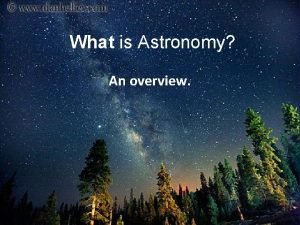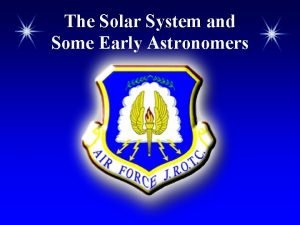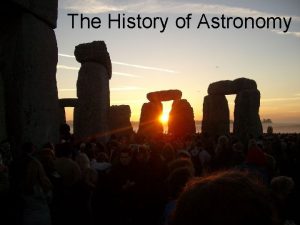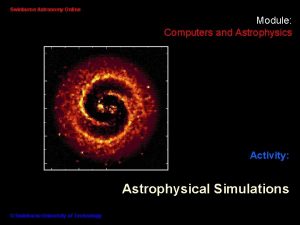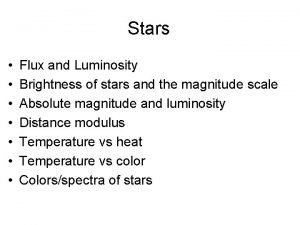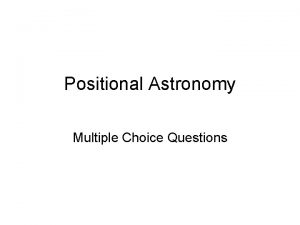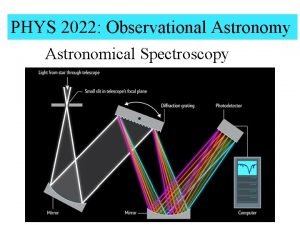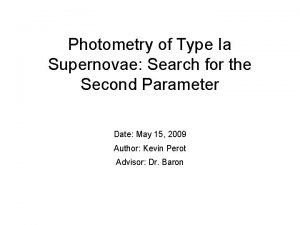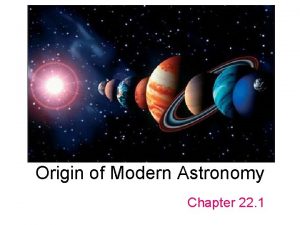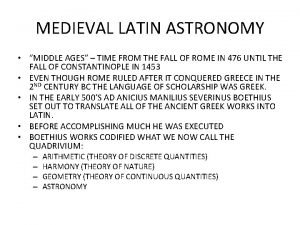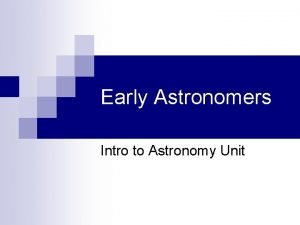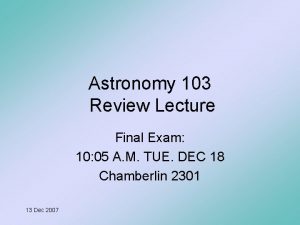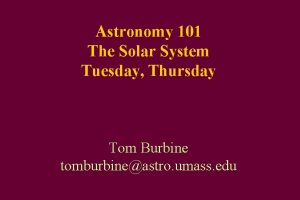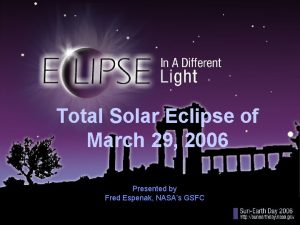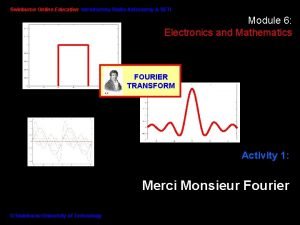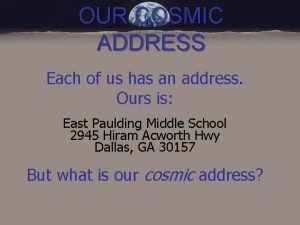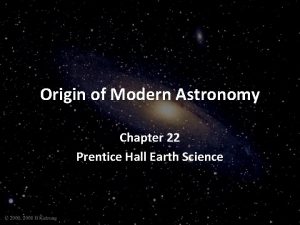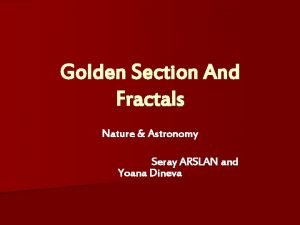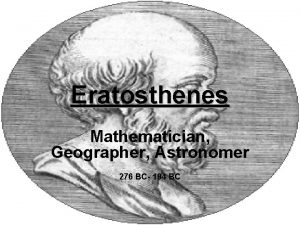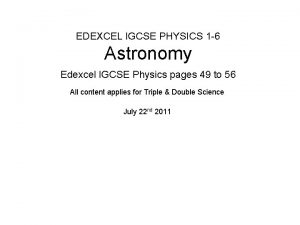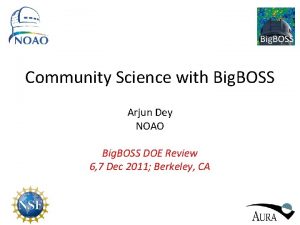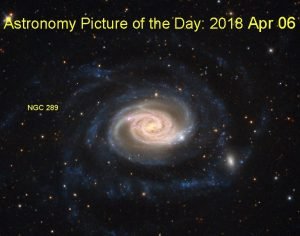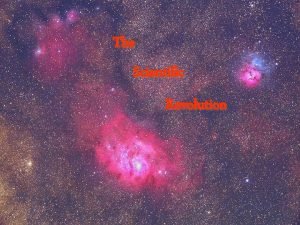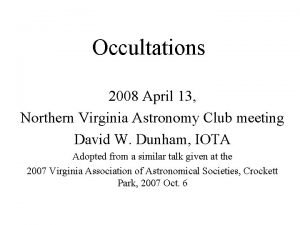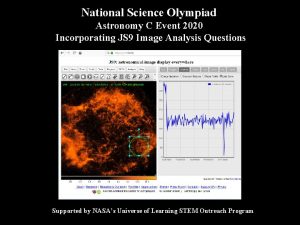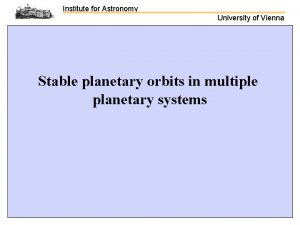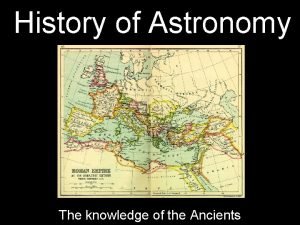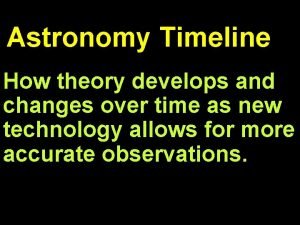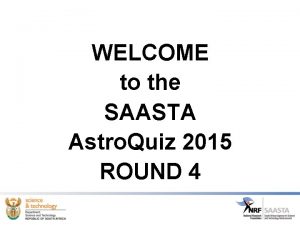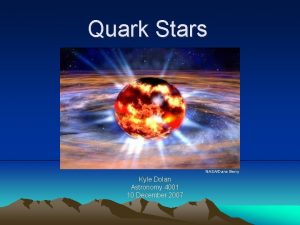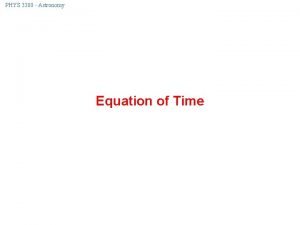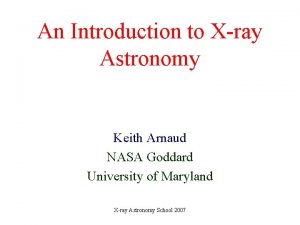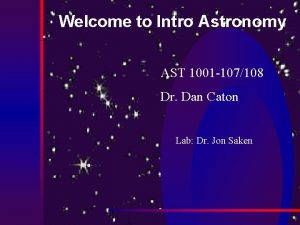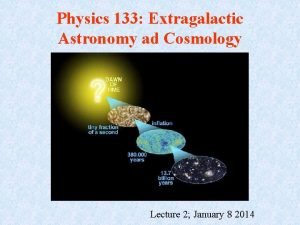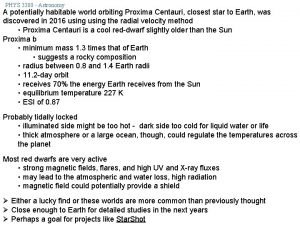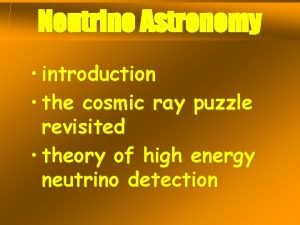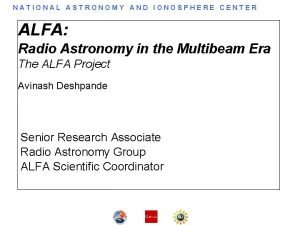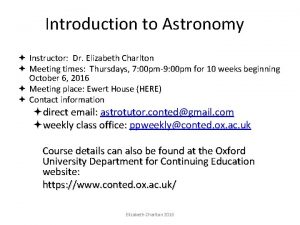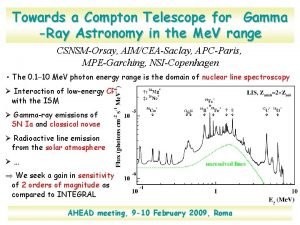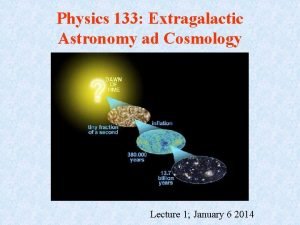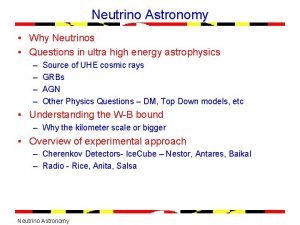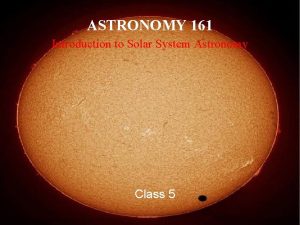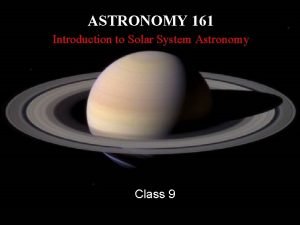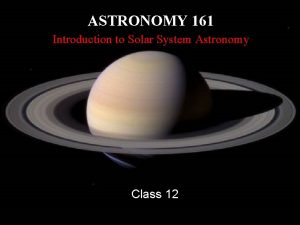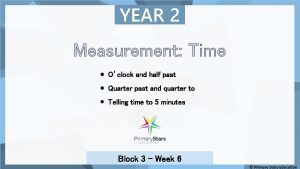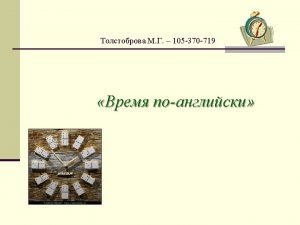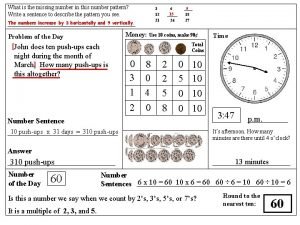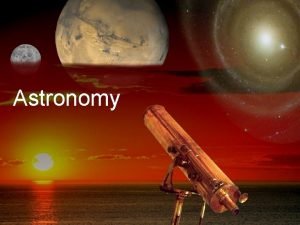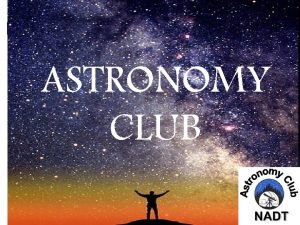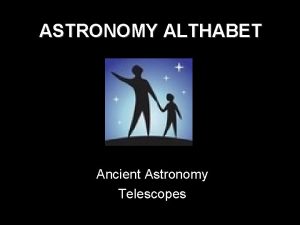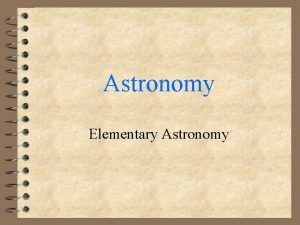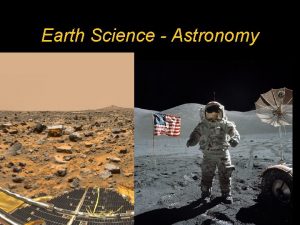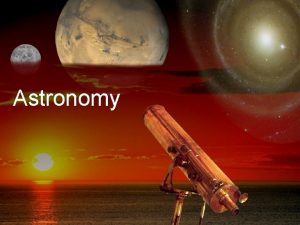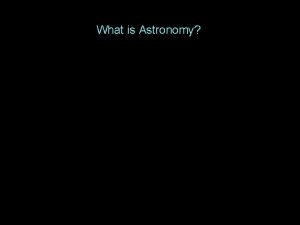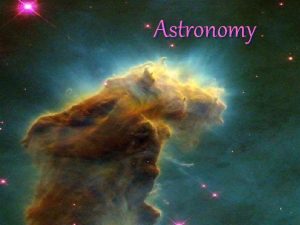Astronomy Quarter 4 Week 29 Question How many





















































































































- Slides: 117

Astronomy Quarter 4

Week 29 Question: • How many planets are in the solar system? Name them in order. FRIDAY 3/23/17 Answer: • 8 planets and 1 dwarf planet • Mercury, Venus, Earth, Mars, Jupiter, Saturn, Uranus, Neptune, and Pluto

Folder Clean-out! • Take ALL papers out of your folder EXCEPT your warm-ups • Prep a sheet of notebook paper with a TITLE named ASTRONOMY

Tour of the Universe Section One

Key Terms • Astronomical unit: the average distance between earth and the sun • Light year: the distance light travels in one year. • Parsec: equal to 3. 26 light years – used for measuring extremely long distances • Sirius: the brightest star in the night sky • Proxima Centauri: the closest star to Earth other than the Sun – 4. 24 light years away • Milky Way Galaxy: a spiral galaxy that WE live in • Local Group: the 30 closest galaxies to US including the Milky Way Galaxy

What are the planets order? • My • Very • Educated • Mother • Just • Served • Us • Nine • Pizzas • • • Mercury Venus Earth Mars Jupiter Saturn Uranus Neptune Pluto – dwarf planet

• The Sun is an average sized star • It has 5 billion years of fuel left

Our Sun in Comparison

Our sun in comparison…

Our sun in comparison…

Let’s look into how much distance is between the planets of our solar system… Paper folding – distance between planets activity. 1. Write Sun at the left side of paper and Pluto on the right side of paper 2. Turn strip over and refold halfway between Sun and Pluto. On the crease, write Uranus. 3. Fold Pluto to Uranus. Write Neptune. 4. Fold Sun to Uranus. Write Saturn. 5. Fold Sun to Saturn. Write Jupiter. 6. Fold Sun to Jupiter. Write Asteroid Belt. 7. Fold Sun to Asteroid Belt. Write Mars. 8. Fold Sun to Mars. Write Venus. 9. Write Mercury in between Sun and Venus. 10. Ask students which planet is missing. Write Earth in between Venus and Mars.

Week 30 Question: What are the 3 units of measure used to describe distance in space? MONDAY 3/27/17 Answer: • Astronomical Unit • Light Year • Parsec

Bill Nye Video – Distances Between Planets • click here to watch the video

What is the closest star to us other than the sun? • Proxima Centauri: 4. 24 light years away • It would take us 4. 24 years to travel to this star if we traveled at the speed of light. • NOTE: Just because it is the closest does not mean it is the brightest star in the night sky! • Sirius is the brightest star – 20 times brighter than our sun. Locating Sirius in the night sky

ORION SIRIUS

What units are used to measure distance in space? • AU or Astronomical Unit: is the average distance between the Earth and the Sun, which is about 93 million miles. • Light Year: this distance light travels in one year. • Speed of light is 186, 000 mi/sec or 300, 000 km/sec • To get an idea of the speed of a light, it would take one second to travel around the earth 7. 5 times. • A light year is 6 trillion (6, 000, 000) miles or 10 trillion km (10, 000, 000) • Parsec: equal to 3. 26 light years

Practice Worksheet 4. 3 LY 9 LY 500 LY 26 LY 680 LY – north star

QUESTIONS 43, 000, 000 km / 28, 000 km/hr = The DISTANCE light travels in one year 10, 000, 000 km distance 1, 535, 714, 285 hrs / 24 hrs/day = 63, 988, 095 days / 365 days/year = 175, 309 years The distance is too far – the number would be too big if we used km 4. 24 LY– Proxima Centauri Everything in space is too far! It would take too long to get there!

Week 30 Question: Convert 145, 000, 000 km into light years TUESDAY 3/28/17 Answer: 145, 000, 000 km 10, 000, 000 km 145 / 10 = 14. 5 Light Years Convert 12, 000 into scientific notation 1. 2 x 107

Comprehending the Vastness of Our Universe

Powers of Ten and Scientific Notation Since the universe is so LARGE (distance and numbers of objects), we must use the powers of ten to help communicate the numbers effectively. Move the decimal point to the right • • • 100=1 101=10 102=100 103=1, 000 104=10, 000 105=100, 000 106=1, 000 (million) 109=1, 000, 000 (billion) 1011=100, 000, 000 (hundred billion) 1012=1, 000, 000 (trillion) Move the decimal point to the left • • • 100=1 10 -1=0. 1 10 -2=0. 01 10 -3=0. 001 10 -4=0. 0001 10 -5=0. 00001 10 -6=0. 000001 10 -9=0. 00001 10 -11=0. 000001 10 -12=0. 0000001

Example Move the decimal to the LEFT 8 places Move the decimal to the RIGHT 12 places

Practice • There are 2 hundred billion stars in our Milky Way Galaxy • What does 2 hundred billion look like? • 200, 000, 000 • What does that look like in scientific notation? • 2 x 10 11

Sand Activity – Making the Connection • The exact scale of the universe is too immense for our minds to understand. We can, however, try to understand the size of the universe by trying to comprehend the contents of the universe-namely the amount of stars there are. 1. Teacher distributes a PINCH of sand 2. Students count the sand grains – how many are there? - Put in scientific notation 3. How many grains of sand do you think there are on earth? - There are 1018 grains of sand on all of the world’s beaches – 1, 000, 000 4. There approximately 20, 000, 000, 000 stars in the universe - 2 x 1028 5. Compare the two amounts 20, 000, 000, 000 1, 000, 000

• Our solar system is part of the MILKY WAY GALAXY (we live here) • Our Sun is one of 200, 000 (billion) stars in the MILKY WAY GALAXY • The Milky Way belongs to a group of galaxies called the LOCAL GROUP • There are 30 galaxies in the LOCAL GROUP

The Milky Way Galaxy

What are these dots? STARS? Not exactly! Each dot is an entire GALAXY! Picture taken from our Hubble Space Telescope

HOW MANY STARS ARE THERE? 200, 000, 000 stars x 100, 000, 000 galaxies = 20, 000, 000, 000 stars *Importance of exponents – powers of 10* 2 x 1028 stars

Powers of Ten • This video shows us traveling outward through space and back again. • Each circle represents a size 10 times greater than the circler before. This is the power of 10. • click here to watch video

Practice Scientific Notation Put the following into scientific notation or standard form… 1. ) The moon is 230, 000 miles from earth 2. 3 x 10 5 miles 2. ) Earth is 93, 000 miles from the Sun 9. 3 x 10 7 miles 3. ) Pluto is 6, 000, 000 miles from the Sun 6 x 10 9 miles 4. ) Proxima Centauri is 43, 000, 000 km from Earth 4. 3 x 10 13 km 5. ) The universe is 4. 6 X 1010 light years across 46, 000, 000 LY

Week 30 3/29/17 Question: Put 78, 900, 000, 000 into scientific notation. Put 5. 2 x 108 in standard form. Wednesday Answer: 7. 89 x 10 13 520, 000

Review Sheet (may be used as a check point quiz)

Week 31 Question: Explain why it is necessary to use the scientific notation and units such as light years when dealing with astronomy. Monday 4/3/17 Answer: The numbers of objects and distances in space are too large to use regular standard units.

Origins of the Universe Section Two

Key Terms: • Big Bang Theory: the most commonly accepted theory explain the creation of the universe • Red shift: stating that everything in the universe is moving away from each other • Blue shift: stating that objects are getting closer – moving toward each other • Electromagnetic Spectrum: the range of wavelengths or frequencies over which radiation (light) extends. • Edwin Hubble: Developed the idea of the Red Shift in 1929 based on a study of the light received from the distant galaxies. • Spectroscope: a tool used to measure the wavelengths of light. • Angstrom: a unit used to represent wavelengths of light (color)

The Big Bang Theory • The Big Bang Theory is the leading explanation about how the universe began. • It was the creation of time and space – time and space did not exist before this point. • In the most general terms, it talks about the universe as we know it starting with a small point of singularity, then inflating over the next 13. 8 billion years to the cosmos that we know today


The Big Bang – Brain Pop Login Info: • Username: d 303 fox • Password: brainpop click here to access video QUESTIONS: 1. How old is our universe? 2. What did the Big Bang (cosmic explosion) create? 3. How does the raisin bread example relate to the Big Bang?

Week 31 Tuesday Question: What two things did the Big Bang create? Answer: Time and space 4/4/17

CANDY JAR WINNER!!! • A four-way tie • Bree Blake – Kaitlyn Sheckells – Jasmine Jordan – Zion Hayes • With guesses of 350 • And an actual total of 346 • The winner is……. • JASMINE JORDAN!!!!

Understanding the Evidence that Proves the Big Bang…

Electromagnetic Spectrum– Brain Pop Login Info: • Username: d 303 fox • Password: brainpop click here to access the video

Why do we view the Sun in different wavelengths? Read article

Regular view UV wavelength light

Electromagnetic Spectrum (The EM Spectrum) • Displays all types of light • Visible light is only a small portion of this spectrum • The type of wave depends on the frequency that the light is traveling.

Frequency

Electromagnetic Spectrum Higher Frequency Lower Frequency

White Light - (Visible Light) • Light is made up of all of the colors of the rainbow ROY G BIV • Red is lowest frequency – what color are the coolest burning stars? RED • Violet is highest frequency – what color are the hottest burning stars? BLUE/VIOLET • White light can be refracted (bent) to expose all colors in a frequency using a prism


Refraction of Light Through a Spectrum • Short waves (high frequency) bends more than long waves (low frequency) Prism

The Angstrom • Unit for measuring color wavelength • What is your favorite color?

Three Types of Spectra

Continuous Spectrum • Full spectrum rainbow. • Created by pure white light being broken into different colors

Emission Spectrum (Bright Line Spectrum) • Every gas produces its own specific wavelengths of light when glows. • When the light is broken down, only a few colors are present in the spectrum. • No two gases have like spectrum. Acts as a fingerprint. H

Absorption Spectrum • When white light passes through a gas and certain wavelengths are absorbed. • Only the frequencies of that certain gas are absorbed • Once again, the spectrum is the fingerprint of that gas H

Spectra (Fingerprint) for Hydrogen Emission Spectrum Absorption Spectrum The lines are in the identical places!

Elements and their Spectrum

NEON CHLORINE Elements may have similar spectrum, but no two elements share the same. BROMINE BORON

What happened to the spectrum of this star over time? Which way did it move? What’s happening?

Do Demo Use spectroscopes and 3 D glasses to view white light and light emitted from gas tubes/bulbs

Understanding the Red Shift • click here to watch video • What happens to the frequency of the waves as an object as it approaches us? • What happens to the frequency of an object as it moves away from us? • What color has the highest frequency? • What color has the lowest frequency? • How can we use the Doppler Effect (Red Shift) to explain the Big Bang?

Week 31 4/5/17 Wednesday Question: How does the Red Shift explain the Big Bang? Answer: Objects moving away lose frequency – it shifts towards the wavelength of RED – galaxies appear slightly red – if we reverse the path of the galaxies, it leads back to a point of singularity.

D B F E A G gain frequency and move towards us C TIME SPACE 14 billion years old RED Visible light

Key Terms: • Ellipse: an oval whose shape is determined by 2 points within the figure called a foci (focus) • Orbit: the path (revolution) that a celestial object takes around a larger celestial object (sun) • Johannes Kepler: German astronomer who discovered three major laws of planetary motion • Constant: something that remains the same • Law of Ellipses: Kepler’s first law – All planets move about the Sun in elliptical orbits, having the Sun as one of the foci. F 1 + F 2 = constant.

Kepler’s Laws • Johannes Kepler (1571 -1630) was able to explain detailed observations using mathematical equations. • Kepler developed three laws that explained most aspects of planetary motion. • Law of Ellipses, Law of Equal Areas, and Law of Periods. Law of Ellipses- Kepler’s first law that states that each planet orbits the sun in a path called an ellipse. • What is an ellipse? ___________________

Planet Foci #1 Foci #2

Law of Ellipses continued… • An ellipse is an oval whose shape is determined by 2 points within the figure called a foci (focus) • The sun represents one of the foci located within an a planets orbit (ellipse). • The law also states that if you draw a line from any point on the ellipse to each of the two foci, the total length of the lines will always be the same. • This is known as a _________. • F 1 + F 2 = __________

F 1 F 2

Ellipses continued… • This law still applies with circles, but a circle is a special type of an ellipse. • The two focus points are on top of each other which allows for the orbit to be a circle instead of an ellipse. • The closer the two focus points are together, the more the orbit will look like a _______.

Ellipses continued • Because orbits of planets are ellipses, a planet is not always the same distance from the sun. • The position where a planet is the closest to the sun around its orbit is called the perihelion. • The point where the planet is the farthest from the sun around its orbit is known as the aphelion.


Distances to the Sun – Aphelion and Perihelion • If a planet is not always the same distance from the sun, then how do we give just once distance when asked how far a planet is from the sun? _______________________________. • The average of these two distances is known as an ___________. • Earth’s distance at ___________ is 152 million km from the sun and 147 million km from the sun at ____________. • What’s Earth’s average distance from the sun? ________ km – This is ONE astronomical unit.

ACTIVITY – each centimeter represents 10 million miles 1. Use the notepad, tacks, and string to create an ellipse. 2. Label one focus point as the sun and the other as focus #2 3. Draw two points along your ellipse (orbit) - Label one of the points planet position one and the other planet position two 4. Use a ruler to draw lines from Planet One to each focus point 5. Use a ruler to draw a line from Planet Two to each focus point 6. Use the ruler to measure the length for lines F 1 and F 2 for each planet position point - What is the sum for each planet? Are they the same or very close to the same value? If so, write TRUE – if not write FALSE 7. Determine the average distance between the sun and your planet - aphelion + perihelion / 2 = ________ 8. How many AU’s is your planet from the sun? - Hint: your average distance in miles divided by 93, 000 miles (1 AU) 9. Is your planet farther or closer to the Sun than Earth?

Week 31 Question: What is the constant of Kepler’s 1 st law? Thursday Answer: F 1 + F 2 = constant 4/6/17

ACTIVITY – each centimeter represents 10 million miles 1. Use the notepad, tacks, and string to create an ellipse. 2. Label one focus point as the sun and the other as focus #2 3. Draw two points along your ellipse (orbit) - Label one of the points planet position one and the other planet position two 4. Use a ruler to draw lines from Planet One to each focus point 5. Use a ruler to draw a line from Planet Two to each focus point 6. Use the ruler to measure the length for lines F 1 and F 2 for each planet position point - What is the sum for each planet? Are they the same or very close to the same value? If so, write TRUE – if not write FALSE 7. Determine the average distance between the sun and your planet - aphelion + perihelion / 2 = ________ 8. How many AU’s is your planet from the sun? - Hint: your average distance in miles divided by 93, 000 miles (1 AU) 9. Is your planet farther or closer to the Sun than Earth?


Week 31 FRIDAY 4/7/17 Question: How do you find the average distance of a planet? Answer: Aphelion + Perihelion / 2 How would you find how many AU’s your planet is from the Sun? Divide by 93, 000 miles (1 AU) PULL OUT YOUR KEY TERMS and HAVE THEM NUMBERED 1 -19

• Astronomical unit • Light year • Parsec • Sirius • Proxima Centauri • Milky Way Galaxy • Local Group • Big Bang Theory • Red shift • • • Blue shift Electromagnetic Spectrum Edwin Hubble Spectroscope Angstrom Ellipse Orbit Johannes Kepler Constant Law of Ellipses

Banana. Gram – Team Roles • Your team will consist of 3 members • One person will be the recorder – writes down the justification for each word • One person will be the speaker – speaks out to the class how each word relates to the STARTER word • One person will be the peace keeper – keeps the team on task, quiet, and all game pieces on the table. • 15 points - formative

Banana. Gram Activity 1. Start with the word BIG BANG 2. Use the tiles to build other astronomy related words stemming from the starting word – BIG BANG 3. For each word used, write down the word and a rationale for how it is related to astronomy 4. The WILD tiles may be used – only one per word 5. After 15 minutes we will see who has the MOST words. 6. That group will share out their words and rationales to the class and the class will be able to agree or disagree if the words are related to astronomy or not. 7. The group sharing may be asked to provide more reasoning for how their word can be related to astronomy – if it doesn’t relate, the word does not count.

Week 32 4/18/17 Question: What is it called when the earth is closest to the Sun and when it’s farthest? Tuesday Answer: Closest: perihelion Farthest: aphelion

KAHOOT

Law of Ellipse Practice Worksheet

Week 32 Wednesday Question: If a planet is 2. 65 AU’s from the Sun, is it farther or closer to the Sun than Earth? How do you know? 4/18/17 Answer: FARTHER – because Earth is 1 AU and 2. 65 AU’s is greater than (farther than) 1 AU.

FINDING THE AVERAGE DISTANCE 1. Aphelion + Perihelion / 2 = average distance 2. Use the scale of 1 cm = 10, 000 miles to convert your distance into miles 3. Divide your number of miles by 93, 000 (1 AU) to convert your total into AU’s perihelion aphelion

Johannes Kepler – Law of Equal Areas

Kepler’s 2 nd Law – Law of Equal Areas • Law of Equal Areas- describes the speed at which planets travel at different points in their orbits. • He found that Earth moves fastest when it is closest to the Sun due to a slightly stronger gravitational pull. Perihelion • What is this area called? __________ • He calculated that a line from the center of the sun to the center of the planet sweeps through equal areas in equal periods of time.


Animation • click here to access the animation for Kepler's 2 nd law

Proving Kepler’s 2 nd Law • So if we were to find the area of each section of a planets orbit that has traveled the same time period, what should we see? • That each section’s area is the same. • Let’s try it! – Count up the blocks in the graph for each section. Pass this out to students • Now before you find the area, what problem might we have? • Some blocks aren’t full and the total might not match up perfectly.


Kepler’s rd 3 Law – Law of Periods • Law of Periods: describes the relationship between the average distance of a planet from the sun and the orbit of the planet. • What do you think an orbit period is? • The orbit period is the time required for the planet to make one full revolution around the sun. • According to Kepler’s 3 rd law, the cube of the average distance of a planet from the sun (r) is always equal to the square of the period (p). • r 3 = p 2 r = AU’s and p = orbit period


Law of Periods Continued. . . • In other words, if you know the average distance of a planet to the sun, then you should know how long its orbit period is, or vice versa. • Ex. – Jupiter is 5. 2 AU’s from the sun Average distance between earth and the sun • What is an AU? ___________ • What variable would the AU represent? r or p? R_____ - radius • Jupiter’s period is 11. 9 years. • How would you set up the formula to check if the orbit period and distance to the sun are proportional? ~ 5. 23 = 11. 92 - Are they the same value?

Law of Periods Continued. . . • What did you get when you solved the formula? • What do you notice? • Any variation on your answer is due to rounding. When the distance is calculated with enough accuracy, the distance cubed always equals the period squared. • We said if we know either the period or the distance that we should be able to find the other. • If a planet is 8. 2 AU’s from the sun, how long is its orbit period? • How would you find this answer? Cube 8. 2

EXAMPLE: Does the orbit period accurately represent the average distance? r 3 = p 2 AU = 10 and orbit period = 31. 62 years • First: take the AU and cube it 1000 • Second: take that number and find the square root of it 31. 62 years • Third: check your answer – take 31. 62 and square it • Final: if r 3 and p 2 are the same, then the information presented is correct.

Practice Problems • Determine whether the equation proves Kepler’s 3 rd law or not. Answer with a YES or NO. YES • AU = 8 and orbit period = 22. 63 years • AU = 3 and orbit period = 5. 2 years YES • AU = 12 and orbit period = 42. 7 years • If the AU is 17, what is the orbit period? NO 70. 09 years

EXIT SLIP • Use the AU of your planet from your worksheet yesterday (. 62) to determine its orbit period. • Show the work!

ANSWER AU =. 623 = 0. 238328 Square root of 0. 238328 = 0. 49 years (orbit period) CHECK IT r 3 = p 2 0. 623 = 0. 492 0. 24 = 0. 24

Week 32 Thursday 4/20/17 Question: If a planet’s AU is 11, how long will it take for the planet to revolve around the Sun? Check your answer. Answer: R 3 : 113 = 1331 1. ) Cube it 2. ) Square root of it 3. ) Square it Check It: 36. 482 = 1330. 7 Orbit Period: Square root of 1331 = 36. 48 years 1331 = 1330. 7 YES!!

CHECK POINT QUIZ – Kepler’s Laws

Week 32 FRIDAY 4/21/17 Question: If aphelion is 200 million miles and perihelion is 180 million miles, how many AU’s is the planet from the Sun? Answer: 200 + 180 = 380 million miles Is it closer or farther than earth? 2. 04 AU’s 380 million miles / 2 million miles = 190 million / 93 million = FARTHER

ALIEN LIFE? ? ? WHO/WHAT’S OUT THERE? !? !

The Drake Equation – Is there Life Out There? Distribute and read the article, then answer the questions… (next slide)

Article Questions: 1. What is the Drake Equation? 2. Who developed the Equation and in what year? 3. Currently, what is the challenge that astronomers have pertaining to the equation? 4. What do you think an exoplanet is? 5. When was the first exoplanet discovered? 6. How are exoplanets discovered? 7. In the Milky Way galaxy, on average, how many planets revolve around each star? 8. How many planets are estimated to be in the Milky Way Galaxy? 9. How many exoplanets have been confirmed as of March 2014? 10. What factors come into play when determining if a planet is suitable for life? 11. How many planets could be suitable for life?

VIDEO LINK click here to learn about the Fermi Paradox click here to watch a video explaining the Drake Equation

QUICK PREASSESSMENT • Take out a piece of paper and answer the questions on the next few slides… • This is NOT a grade!

SEASONS – what do you know? What causes Earth’s seasons? a. ) how close earth is to the sun? b. ) global warming c. ) the tilt of earth on its axis d. ) seasons are random

At what position in the sky is the sun the most intense? a. ) low on the horizon b. ) directly above us

When will the sun’s radiation be most intense? a. ) when it rays create a large angle between itself and earth b. ) when its rays create an acute angle between itself and earth c. ) when its rays create a 90 degree angle between itself and earth

The horizontal lines measuring north and south on the globe are called lines of… a. ) longitude b. ) latitude c. ) contour d. ) equator

Day and night on earth and created from Earth’s what? a. ) rotation b. ) revolution c. ) orbital period

The solstice describes what? a. ) summer/winter b. ) spring/fall c. ) fall/summer d. ) winter/spring

Key Terms • Axis: An imaginary line around which a planet spins. On Earth, it marks the North and South poles. • Rotation: the spinning of earth on its axis – day and night • Revolution: earth going around the sun – year • Leap year: A year containing an extra day to make up for the extra. 25 d each revolution. Used in order to keep the calendar months in synch with the seasons. • Latitude: A measure of degrees, North to South, on the globe. • Direct light: Light that hits the surface of the Earth at a 90° angle. Very concentrated; hot. • Northern Hemisphere: lines of latitude or the area North of the equator • Southern Hemisphere: lines of latitude or areas South of the equator • Vernal equinox: The first day of spring (21 MAR in Northern hemisphere) • Autumnal equinox: The first day of fall (21 SEP in Northern hemisphere) • Summer Solstice: The first day of summer (21 JUN in Northern hemisphere) – longest period of daylight • Winter Solstice: The first day of winter (21 DEC in Northern Hemisphere) – shortest period of daylight

Essential Questions • Why does earth have seasons? • When is the sun’s radiation most intense? • What happens to the intensity of the Sun’s radiation as latitude increases or decreases? • Why are there 24 hrs of darkness/daylight in the Arctic Circle?

BRAINPOP - Seasons 1. ) How much does earth tilt on its axis? 2. ) What is the only place that gets direct light every day of the year? 3. ) What are the only two areas that don’t have a FALL or SPRING season? 4. ) What season is it in the southern hemisphere when it is summer in the northern hemisphere? click here to access the brainpop video Login Info: Username: d 303 fox Password: brainpop

Quizlet – Seasons Key Terms • click here to access the quizlet
 Learning astronomy by doing astronomy activity 1 answers
Learning astronomy by doing astronomy activity 1 answers Learning astronomy by doing astronomy activity 1 answers
Learning astronomy by doing astronomy activity 1 answers Learning astronomy by doing astronomy activity 1 answers
Learning astronomy by doing astronomy activity 1 answers Difference between quarter past and quarter to
Difference between quarter past and quarter to Quarter half past
Quarter half past English 5 quarter 1 week 3
English 5 quarter 1 week 3 English 9 quarter 2 week 3
English 9 quarter 2 week 3 Costas level of questioning
Costas level of questioning Week by week plans for documenting children's development
Week by week plans for documenting children's development Question word simple present
Question word simple present Closed questions
Closed questions Contoh open question
Contoh open question Situation producing questions in research examples
Situation producing questions in research examples Indirect questions introductory phrases
Indirect questions introductory phrases What is a compelling question
What is a compelling question Compelling and supporting questions examples
Compelling and supporting questions examples How to write 5 marks questions in english
How to write 5 marks questions in english Many sellers many buyers
Many sellers many buyers Er diagram
Er diagram Unary many to many
Unary many to many Erm vs erd
Erm vs erd Unary many to many
Unary many to many Erd ratio
Erd ratio Unary many to many
Unary many to many Many-to-many communication
Many-to-many communication Sqlbi many to many
Sqlbi many to many Unary relationship database
Unary relationship database Many sellers and many buyers
Many sellers and many buyers Branches of astronomy
Branches of astronomy Claudius ptolemy astronomy contributions
Claudius ptolemy astronomy contributions Aristotle astronomy
Aristotle astronomy Swinburne astronomy
Swinburne astronomy Astronomy
Astronomy Astronomy
Astronomy Vireo astronomy
Vireo astronomy Astronomy questions and answers multiple choice
Astronomy questions and answers multiple choice Astronomy
Astronomy Distance ladder astronomy
Distance ladder astronomy Origin of modern astronomy chapter 22
Origin of modern astronomy chapter 22 Astronomy in medieval times
Astronomy in medieval times Astronomy definition earth science
Astronomy definition earth science Claudius ptolemy astronomy contributions
Claudius ptolemy astronomy contributions Cuhk astronomy
Cuhk astronomy Atronomy vs astrology
Atronomy vs astrology Astronomy forum uk
Astronomy forum uk Astronomy 103 final exam
Astronomy 103 final exam Astronomy 101 formulas
Astronomy 101 formulas Astronomy science fair projects
Astronomy science fair projects Astronomy picture of the day march 29 2006
Astronomy picture of the day march 29 2006 Time domain astronomy
Time domain astronomy Antwrp
Antwrp Cosmic address
Cosmic address Tycho brahe believed that
Tycho brahe believed that Netherlands institute for radio astronomy
Netherlands institute for radio astronomy Radio astronomy lectures
Radio astronomy lectures Astronomy picture of the day
Astronomy picture of the day Time domain astronomy
Time domain astronomy Golden ratio in astronomy
Golden ratio in astronomy Telescope training
Telescope training Eratosthenes contributions to astronomy
Eratosthenes contributions to astronomy Igcse astronomy
Igcse astronomy Michigan state astronomy
Michigan state astronomy Time domain astronomy
Time domain astronomy Astronomy picture of the day 17 april 2001
Astronomy picture of the day 17 april 2001 Astronomy 161
Astronomy 161 Tycho brahe astronomy
Tycho brahe astronomy Northern virginia astronomy club
Northern virginia astronomy club Js9 imaging analysis software
Js9 imaging analysis software Astronomy
Astronomy Astronomy in ancient rome
Astronomy in ancient rome Astronomy timeline project
Astronomy timeline project High point astronomy
High point astronomy Astro quiz 2019 answers
Astro quiz 2019 answers Astroquiz round 1
Astroquiz round 1 Astronomy
Astronomy Quark astronomy
Quark astronomy Astronomy
Astronomy Branches of astronomy
Branches of astronomy Byu physics minor
Byu physics minor Astronomy
Astronomy Ast 1001
Ast 1001 Deep learning spectroscopy
Deep learning spectroscopy V zc astronomy
V zc astronomy Astronomy
Astronomy Astronomy
Astronomy Ionosphere
Ionosphere Astronomy
Astronomy Astronomy
Astronomy Astronomy
Astronomy Extragalactic astronomy
Extragalactic astronomy Uiuc astronomy 100
Uiuc astronomy 100 Astronomy
Astronomy Solar system astronomy class
Solar system astronomy class Solar system astronomy class
Solar system astronomy class Solar system astronomy class
Solar system astronomy class Astronomy gupta empire
Astronomy gupta empire Chat hull
Chat hull What is this time
What is this time A quarter pass 8
A quarter pass 8 Whats a quarter past 12
Whats a quarter past 12 Quarter to 7 in digital time
Quarter to 7 in digital time Welcome 2nd quarter
Welcome 2nd quarter Welcome to quarter 2
Welcome to quarter 2 It's a quarter to two.
It's a quarter to two. The hands of the clock
The hands of the clock Quarters on a clock
Quarters on a clock Quarter half past
Quarter half past A quarter past 5
A quarter past 5 Quarter redesign
Quarter redesign Quarterly business review template
Quarterly business review template Principles of marketing quarter 2 module 9
Principles of marketing quarter 2 module 9 Principles of marketing module 7 answer key
Principles of marketing module 7 answer key Principles of marketing quarter 2 module 6
Principles of marketing quarter 2 module 6 Three quarter crowns
Three quarter crowns Proximal grooves partial veneer crown
Proximal grooves partial veneer crown Crescent moon symbolism
Crescent moon symbolism Quarter turn belt drive
Quarter turn belt drive Quarter turn belt drive
Quarter turn belt drive




























